Yesterday’s live coverage of the Ukraine conflict can be found here. An archive of our liveblogs can be found here. For an overview and analysis of this developing story see our latest podcast.
Please help The Interpreter to continue providing this valuable information service by making a donation towards our costs.
View Ukraine: April, 2014 in a larger map
For links to individual updates click on the timestamps.
For the latest summary of evidence surrounding the shooting down of flight MH17 see our separate article: Evidence Review: Who Shot Down MH17?
As the international community debates a new round of peace talks to solve the crisis in Ukraine, it’s worth noting that in parts of Ukraine the last peace process has never been implemented.
Journalist Oliver Carroll reports from the front lines:
An area just south of Debaltseve (Debaltsevo), Nikishino, was featured at the beginning of December in an article in Kyiv Post which described the location as the “gates of hell,” or the “Debaltseve cauldron. ”
Nikishino is one of the most advanced positions of the Ukrainian army in the so-called Debaltseve cauldron, a Ukrainian-held area flanked by separatists from the west, south and east. The area has become a major direction of insurgent attacks, with pro-Russian separatists trying to surround Ukrainian troops.
Most of Nikishino is controlled by separatists but Ukrainian troops retain a foothold in the village.
Most locals have fled the village but a lone pensioner lives in a buffer zone between Ukrainian troops and insurgents, said Nikolai, a soldier who has come back from Nikishino and is currently on leave.
Another soldier, also named Nikolai, said that locals had told him the insurgents deceived them with tales of a better life in Russia. He hopes separatists will withdraw on their own because he says they lack local residents’ support.
Earlier this week the OSCE warned of the worsening situation in the Donbass as winter sets in and fighting escalates. Interfax notes that according to the OSCE most of the fighting in eastern Ukraine is near the Donetsk airport, Pisky village, or near “Nikishyne, Chernukhyne, and Debaltseve.”
Today the OSCE says the security situation near Debaltseve has “deteriorated considerably in the preceding 24 hours. “
At the Joint Centre for Control and Co-ordination (JCCC) HQ in government-controlled Debaltseve (55km north-east of Donetsk), the Ukrainian Major-General, head of the Ukrainian side to the JCCC, and the Russian Federation Major-General, representative of the Armed Forces of the Russian Federation to the JCCC, both said the security situation, particularly in areas controlled by the “Donetsk People’s Republic” (“DPR”) had deteriorated considerably in the preceding 24 hours. They said that in the 24 hours preceding 08.00hrs on 8 January, there had been 66 ceasefire violations reported, 29 in government-controlled territory and 37 in “DPR”- or “LPR”- controlled territory. Eighty percent of the incidents were recorded at or in the environs of the Donetsk airport. The remainder were in government-controlled Debaltseve or in “LPR”-controlled territory.
Donetsk airport has been under heavy attack, the most intense rocket barrages in weeks. Earlier we reported that two Ukrainian soldiers had been killed near Stanitsa Luganskaya, to the north-east of separatist-held Lugansk. Now, Interfax reports that the Ukrainian government now says Ukrainian positions have been shelled 34 times since last night and AFP reports that at least four soldiers and four more civilians have been killed today.
Local authorities in the rebel stronghold of Donetsk said another nine residents were injured in sporadic clashes that continued from dawn late into the evening around the industrial city’s disputed airport…
“After a long spell of quiet, the attacks resumed again the tonight,” said Oksana, a 27-year-old mother of three as sporadic booms echoed in distance.
She said neighbourhoods around the airport had been effectively cut off from the rest of the city by the shelling.
“Public transport refuses to come here,” she said.
— James Miller
On January 7 we reported on @DajeyPetros of Ukraine@War‘s discovery of a vast military camp and staging ground in Russia’s Rostov region, not far from the Ukrainian border and erected at some point in 2014.
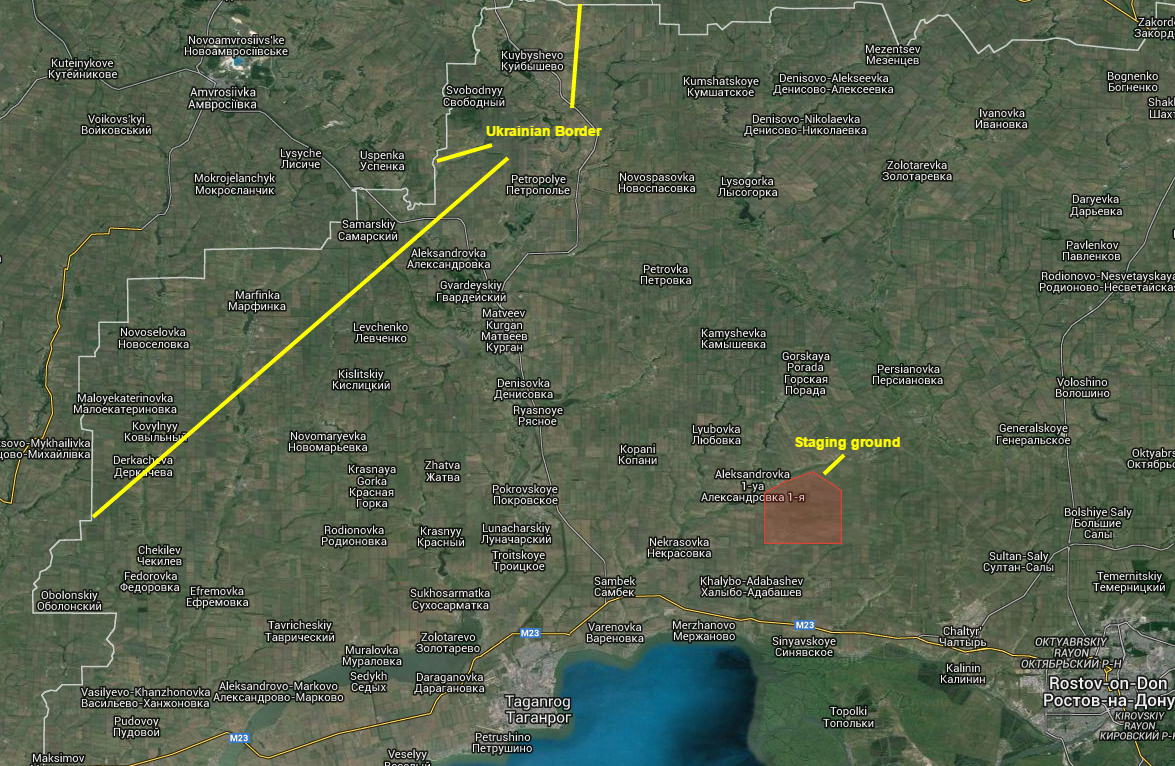
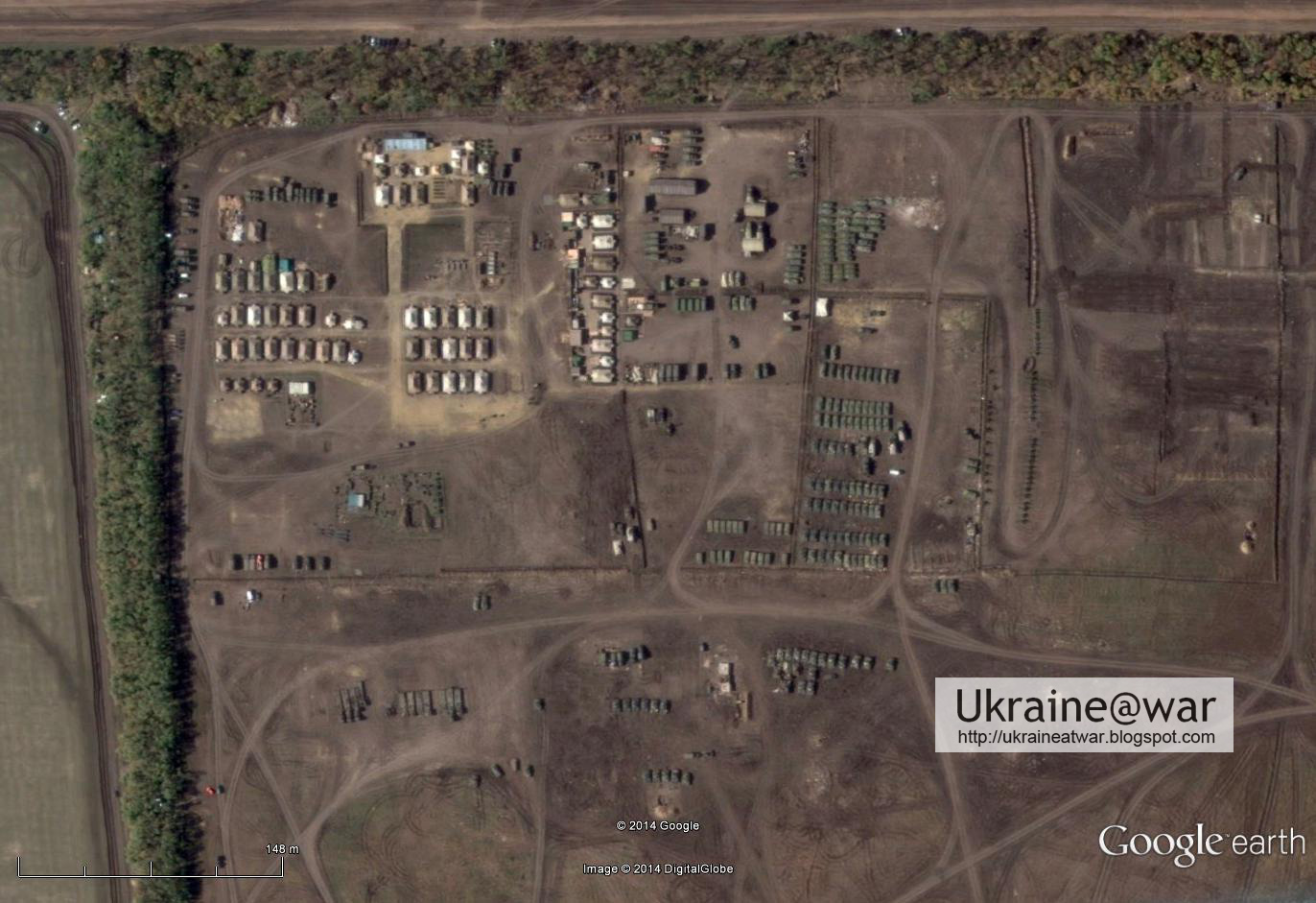
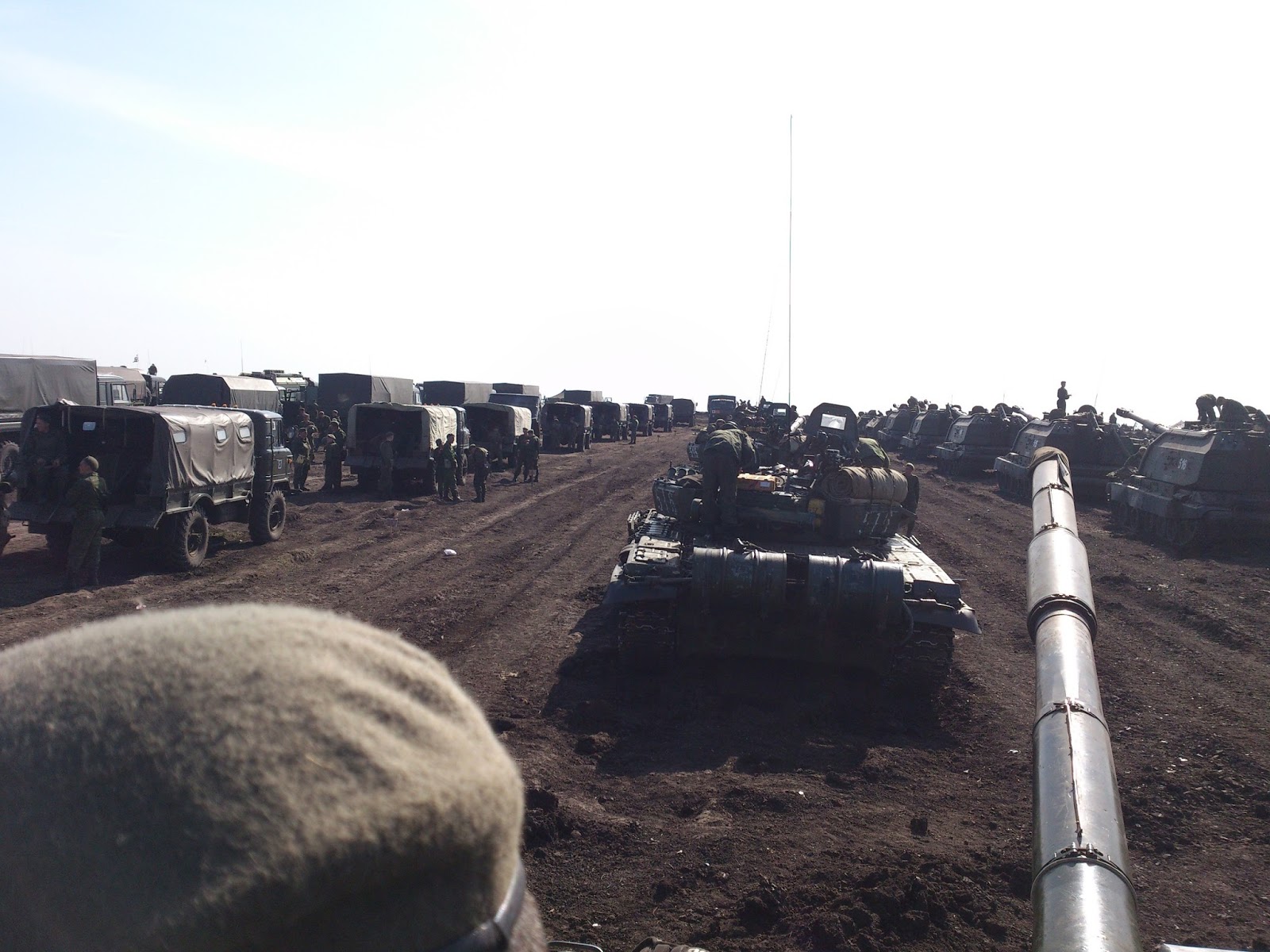
At the time it was noted that there appeared to be a strong similarity between the forces assembled at the site, documented in geotagged photos on Russian soldiers’ VKontakte pages, and a huge column recorded on video in late August last year.
In particular, the composition of both assemblies, including large numbers of both T-90 tanks and 2S19 Msta self-propelled guns, was strikingly similar. We have not, however, been able to geolocate this video so as to prove this is the same location.
A natural question would therefore be whether this huge force has been deployed in Ukrainian territory?
Certainly, the video was recorded shortly before a massive escalation in the conflict, at the end of August and beginning of September, in which regular Russian forces pushed back Ukrainian troops from most of the Lugansk region and invaded along the Azov coast, capturing the town of Novoazovsk.
There is no definitive proof that T-90 tanks have been deployed inside Ukraine. Burkonews, citing reports from InformNapalm, have proposed that a VKontakte album uploaded by a Russian soldier, which showed both photos of soldiers standing by a road sign inside the Lugansk region and also photos of T-90 tanks on manoeuvres, suggest the tanks have been deployed.

However it is common to see large albums of photos uploaded by soldiers in one day on return from deployment. We have not been able to geolocate the photos of T-90s in this album. This does not rule out the possibility that the T-90s in the album were also in Ukraine, but it does not prove it.
Meanwhile, while sightings have been rare, there is some footage that does suggest the deployment of 2s19 Mstas in Ukraine.
This footage, from Al Jazeera, clearly shows 2S19s inside Ukrainian territory, during the invasion of Novoazovsk:
Furthermore, the self-propelled guns have a strikingly similar camouflage pattern to those seen in the video from August.
@DajeyPetros highlighted this for us:
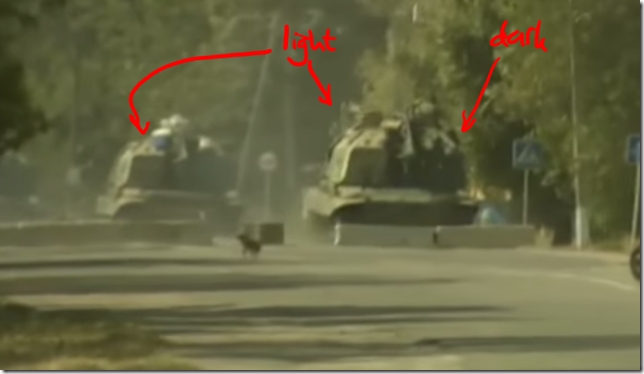
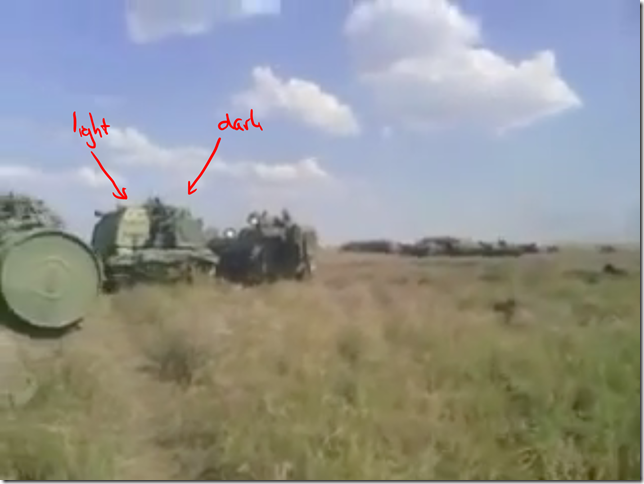
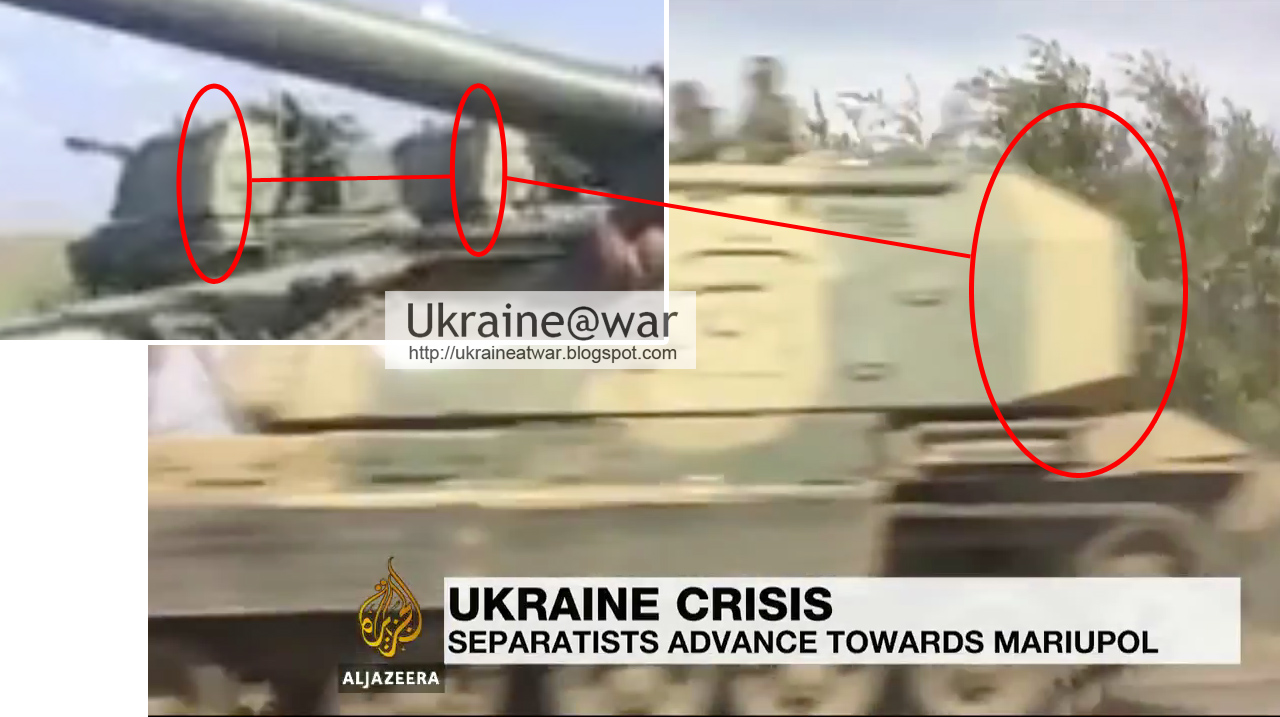
On Ukraine@War @DajeyPetros noted that matching 2S19s, both bearing the same camouflage scheme and “Н2200” marking indicating rail transport, had been filmed in Rostov-on-Don on July 30.
They propose that these vehicles spent the intervening month, before the September invasion, at the Golovinka camp.
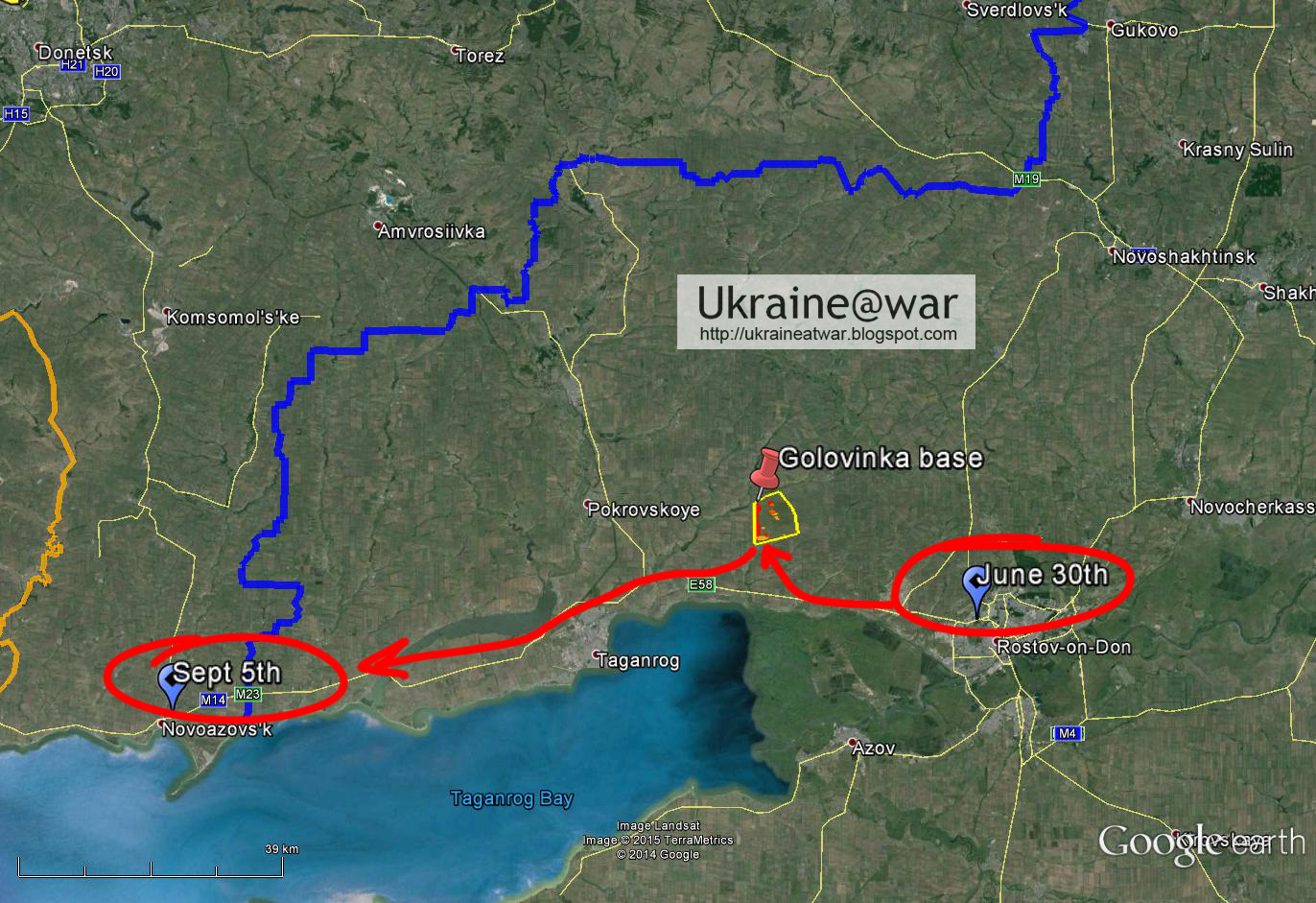
While this suggests at least a partial deployment of the forces at the camp, the satellite photos on Google Maps date from October 10, 2014 and there are VKontakte photos tagged in the area that show snow, suggesting that a significant force is still being maintained there.
Photos from one album which has been associated with the site were uploaded by soldier Aleksandr Maltsev on November 26, 2014. However , again, it is common to see large dumps of photos uploaded in one day. Certainly the same album depicts other sites, including Rostov-on-Don and far-away Altai Krai.
But the photos that show snow, like these uploaded by soldier Sergei Karashevcev in recent days, make it clear that the deployment has lasted well beyond the summer.
Here are some of Karashevcev’s photos, geo-tagged in the Neklinovsky district, where the base is located:
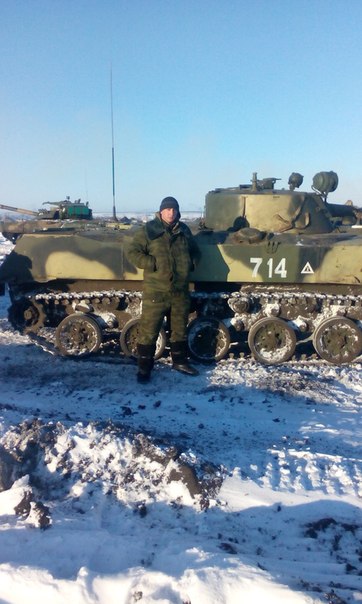
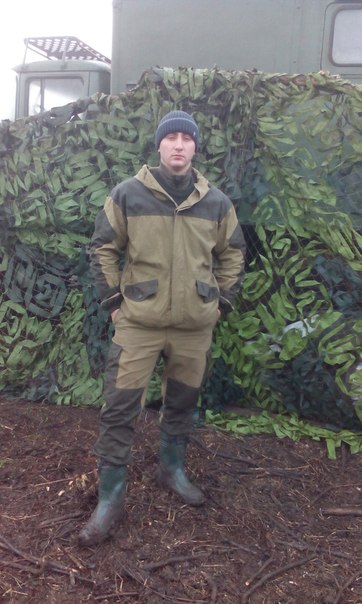
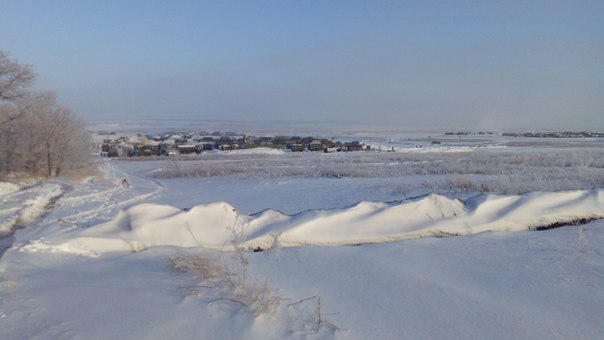
It is interesting to note, however, that in contrast to the preponderance of T-90s seen in previous photos we believe to have been taken at the camp, the tank seen in the background in the first of Karashevcev’s photos, behind the BMD vehicle, appears to be a T-80U.

There are no reported sightings of this type of tank operating inside Ukraine.
Could it be that at the beginning of September, having planned a larger invasion, but with Ukraine having agreed to a truce at the Minsk agreements, and ostensibly deciding on granting the occupied regions “special status,” the Kremlin believed that its short-term goals had been fulfilled? That is to say the creation of a “frozen” conflict zone that debilitates Kiev politically and eats up resources, leaving Moscow with powerful leverage over the Ukrainian government.
But the maintenance of the camp over the winter may also suggest that a wider invasion is still a possibility.
— Pierre Vaux
Translation: #SBU has detained a #DNR fighter who prepared terrorist attack in Zaporozhe.
A DNR fighter known by the nick-name Korol (“King”) was detained on January 6, the SBU press service reported on its Facebook page. The Interpreter has a translation:
The 35-year-old fighter, a resident of Zaporozhe Region, voluntarily joined the unlawful armed formation Vostok in June of this year. He was given arms and sent to guard the administrative building seized by the terrorists in Donetsk. Furthermore, Korol, along with other fighters, carried out armed attacks on the civilian population and Ukrainian soldiers on the territory of the Donetsk region,” says the statement from the SBU.
As was reported by the SBU, the chiefs of the bandit formations personally supplied the criminals with Utes machine guns, automatic grenade launchers (AGS) and RGD-5 grenades.
“Upon returning home, ‘Korol’ on assignments from the ‘DNR’ terrorists began the preparation for the commission of terrorist acts and sabotages of utility buildings in Zaporozhe with the use of arms and explosives,” the press statement continues.
Agents said Korol was looking for helpers to spy on Ukrainian checkpoints and gather intelligence on the utilities buildings. They are currently investigating him.
A number of bombings have occurred in Odessa and Kharkiv in recent weeks, of both utilities and the offices of volunteers groups helping Ukrainian forces.
There an explosion of some medical buildings in Zaporozhe on July 22, but it is not known if this suspect is related to that incident.
— Catherine A. Fitzpatrick
Novosti Donbassa reports that the Ukrainian National Guard has announced that two of its servicemen have been killed and eight wounded during fighting outside government-held Stanitsa Luganskaya, to the north-east of separatist-held Lugansk.
The Interpreter translates:
“Today, January 9, two National Guard soldiers were killed and eight servicemen received wounds of varying severity after an armed confrontation close to Stanitsa Luganskaya in the Lugansk region,” says the announcement.
Action is being taken at the moment to evacuate the dead and provide medical treatment.
Earlier today, at 13:20 GMT, UNIAN reported that the office of the governor of the Lugansk region, Hennadiy Moskal, had announced that a close-quarters fire-fight was under way between Ukrainian and Russian-backed forces, with the use of both automatic weapons and mortars reported.

Moskal’s office also announced that the town had been shelled by Russian-backed forces after noon.
The shelling destroyed a school and damaged homes in the centre of the settlement.
According to the governor’s office, the shelling came from the banks of the Seversky Donets river, under the control of Russian-backed ‘Lugansk People’s Republic’ forces.
Dmytro Tymchuk of Information Resistance wrote on his Facebook page this morning that Russian-backed forces had deployed “up to two consolidated batteries” of artillery, including both mortars and guns, close to both Stanitsa Luganskaya and Schastye.
— Pierre Vaux
The Interpreter has been providing evidence of Russians fighting in eastern Ukraine since the earliest days of the fighting there. We established quickly that the first “little green men” in Crimea were really Russian soldiers. Soon after extremely-well-armed groups of seemingly-elite fighters seized government buildings across eastern Ukraine, there was evidence that many of the most prominent fighters and their leaders were Russian.
But while in Crimea the “little green men” were clearly Russian soldiers, in the early days of the insrugency in the Donbass things were not as clear. In June, we wrote an article entitled Provocations, Proxies and Plausible Deniability: Russia’s remote controlled war in Ukraine. The article explored the essential question: who are the fighters in eastern Ukraine, and what is Russia’s involvement there. At the time there were some indications that Russian special forces were behind some operations, but the origin and nature of many of the fighters was less clear. One thing was clear, however: many Russian citizens, either part of the military, some other ideological group, or through their own volition, were fighting in Ukraine.
At the time we wrote that the Kremlin was using proxies rather than direct intervention in order to retain plausible deniability:
Yet the evidence that conclusively links the Russian government to direct interference on the other side of the border has been more difficult to amass because Vladimir Putin has opted – at least for now – to conduct a “special war” in his neighbor’s territory, one bearing all the hallmarks of maskirovka. Maskirovka is the principle of camouflage or denial and deception established in Soviet military doctrine. The chief features of maskirovka are the maintenance of plausible deniability, concealment of forces, disinformation, and decoy or dummy structures to confuse opponents’ ability to predict and respond to actions.
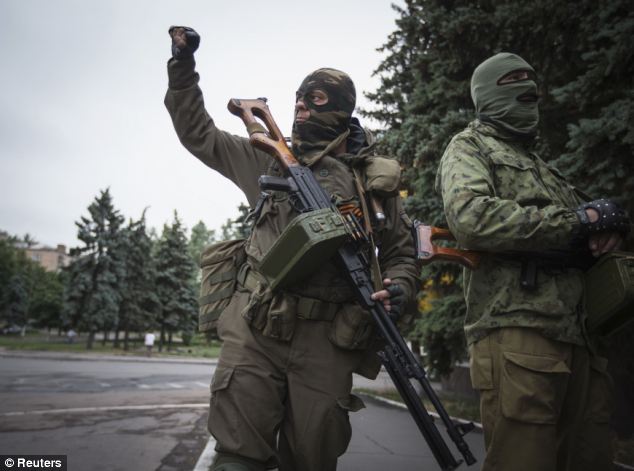
Despite the lack of clear evidence that specific insurgents were members of the Russian military, however, there was ample evidence that Russia was trying to bully Ukraine by moving its troops to Ukraine’s borders. There was also tell-tale circumstantial evidence of Russian special forces operating across the border:
Between June 14th and 16th, however, the Ukrainian military stepped up its anti-terror operations. By the morning of June 16th, a much more robust military response to separatist gains had recaptured Mariupol and was poised to recapture Lugansk and secure the border, thus shutting the separatists off from Russia. In response to this new threat to the insurgency, videos and eyewitness reports back up claims from the Ukrainian government that convoys of Russian troops are once again racing toward the Ukrainian border. After weeks of supposed deescalation, the moment the insurgency is threatened in eastern Ukraine the Kremlin has reacted with an overt threat, an attempt to intimidate Ukraine into halting its success for fear of triggering a Russian military response that would guarantee defeat.
Heavily armed gunmen, many of them Russian citizens, fighting in coordinated attacks, operating with military efficiency, striking targets which suggest the possession of military-grade intelligence, all serve as compelling-but-circumstantial evidence that the separatist insurgents are directly supported by the Russian military intelligence apparatus. But the methodical intersection of the Russian government’s diplomatic, propagandistic, and military actions with the military and political realities on the ground in eastern Ukraine prove that at the very least Russia’s military intelligence complex is coordinating its efforts with the pro-Kremlin separatists in order to destabilize eastern Ukraine and increase Russia’s control over post-Yanukovych Ukraine.
This was, of course, long before the Russian military began supplying, in large-scale and obvious ways, huge amounts of tanks, armored vehicles, advanced anti-aircraft weapons, soldiers, ammunition, rocket launchers, and other supplies, beginning in late July and accelerating until the “Russian invasion” in August. Since then we have documented evidence that this effort has continued.
But it is a mistake to think that all of the Russian-backed separatists are actually Russian military. The proxies remain. Pro-Putin Russians, many of them nationalists who “answered the call,” so to speak, of Russian state-controlled media outlets. Some of them are actual Ukrainians who believe the narrative coming out of the Kremlin. And, yes, some are Russian troops. It’s also true that a significant amount of the equipment and supplies used by these fighters, no matter what their nationality, is still coming from the Kremlin.
The BBC has recently been to eastern Ukraine and encountered fighters who were proud to be Russian and fighting Ukraine.
— James Miller
Nadezhda Savchenko, a Ukrainian military officer who was captured by separatist fighters in the Lugansk region, interrogated on video and subsequently illegal transported to Russia where she is now on trial on charges of murdering two Russian journalists, is on the 28th day of a hunger strike, initiated in protest of the authorities’ refusal to provide medical treatment. She had also complained to both the International Committee of the Red Cross and the Russian Investigative Committee that her status as a prisoner of war, which would necessitate the suspension of her trial, was being ignored. Savchenko is being held in pre-trial detention (SIZO) in Moscow.
One of her lawyers, Mark Feygin, tweeted:
Translation: Nadezhda Savchenko has lost 10 kg [22 pounds] by the 28th day of her hunger strike.
Yesterday, Nikolai Polozov, another of Savchenko’s lawyers, tweeted:
Translation: Every new day of Nadezhda’s hunger strike brings us closer to an impending tragedy. #FreeSavchenko
The spokesman for Ukraine’s National Security and Defence Council, Andrei Lysenko, has told reporters at a briefing in Kiev today that four Ukrainian soldiers have been killed and eight wounded during the last 24 hours, Interfax-Ukraine reports.
Meanwhile, the website of the Donetsk city administration, now headed by the separatist-appointed ‘mayor’ Igor Martynov, carried a report this morning on the deaths of two civilians during heavy shelling yesterday and last night.
The report says that intense shelling struck the Kievsky, Kirovsky, Kuybyshevsky and Petrovsky districts of the city, causing fires and damaging homes and infrastructure.
According to the report, in addition to the two killed, seven civilians received wounds of varying severity.
After overnight shelling, the city was, the announcement said, quite this morning, with no reports of artillery fire.
Translation: Kievsky Prospect, 09/01/15
There is no statement in the report with regards to the source of the shelling.
Covering the announcement by Ukrainian military officials that Russian-backed forces had intensified their attacks ahead of next week’s peace talks in Kazakhstan, AP reported today that:
An AP reporter heard rockets being fired Thursday evening into the separatist stronghold of Donetsk – an indication that government forces are also likely breaching the cease-fire.
The Ukrainian military’s ATO Press Centre announced today that Ukrainian positions had been attacked 34 times during the night. They described this as a marked intensification in attacks.
Ukrainska Pravda reported on the announcement (translated by The Interpreter):
According to the report, the shelling was conducted with heavy weapons – mortars and artillery, including Grad MLRS.
The greatest terrorist activity was observed around Donetsk, however armed provocations were recorded in other areas, reports the press centre.
“Militants fired mortars twice on Donetsk Airport, Veseloye, Tonenkoye, Opytnoe, Marinka, Avdeyevka, Gnutovo, Novotoshkovskoye, twice on Krasnogorovka, and three times on Peski. Terrorists fired with small arms at our positions near Marinka, Nikishino, Kryakovka and Redkodub,” says the statement.
Over the night, militants fired 9 times with artillery and another 5 with Grads.
With artillery, they shelled the settlements of Bolshaya Anadol, Kamenka, Oktyabrskoye, Tonenkoye twice and Gunotovo four times. With Grads they shelled Pavlopol, Raygorodka, Oktyabrskoye and Krymskoye twice.
In addition 8 overflights by unmanned aerial vehicles were recorded over Denezhnikovo, Shcherbak, Panteleymonovka, Schastye, Chmirovka, Kramatorsk and twice over Glinka.
In all, according to the report, over the last 24 hours illegal armed groups have fired on Ukrainian army positions 50 times.
“It seems that another humanitarian convoy brought something other than food to the Donbass,” summarised the press centre.
As reported, over the previous night, militants fired on Ukrainian positions only eight times.
The eleventh Russian “humanitarian convoy” arrived in Ukraine on Thursday.
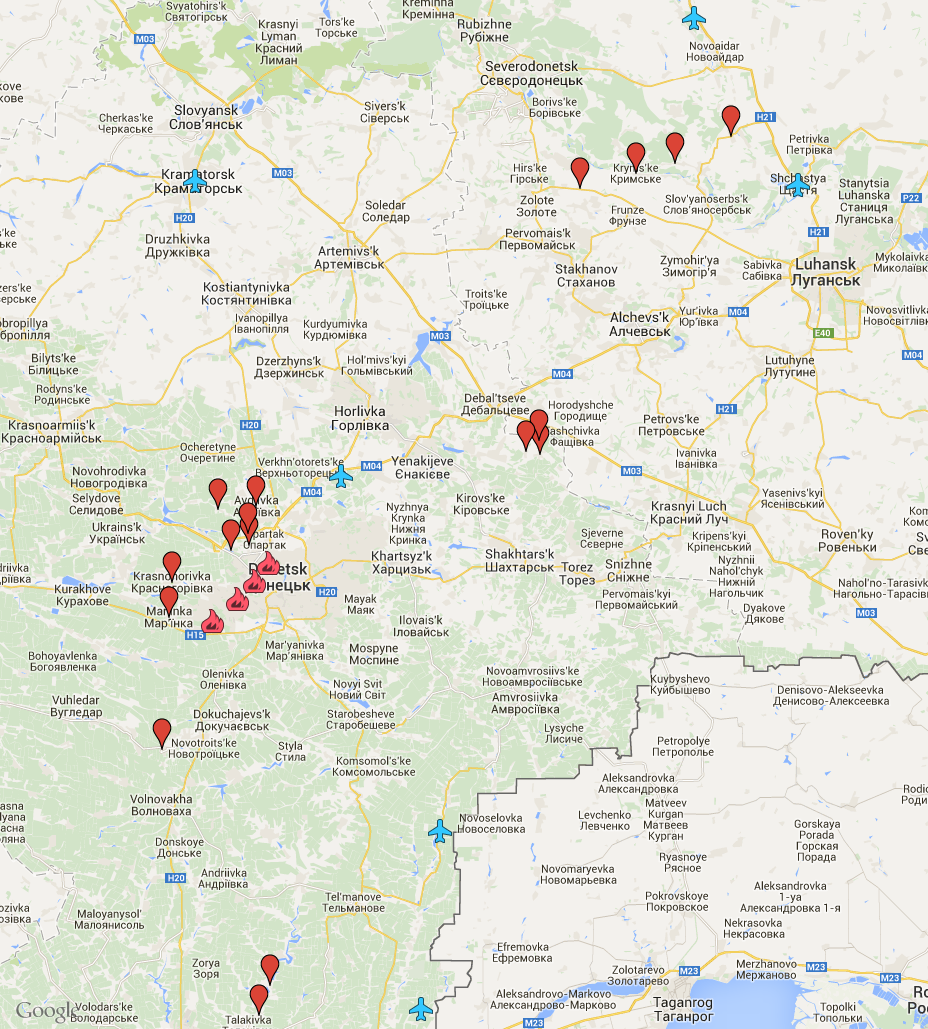
— Pierre Vaux